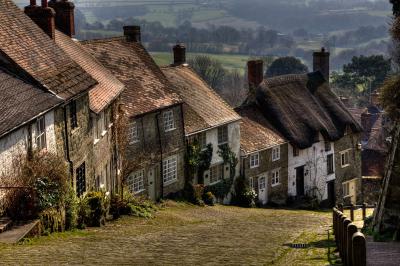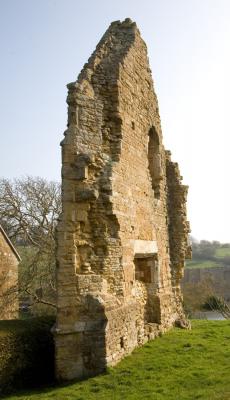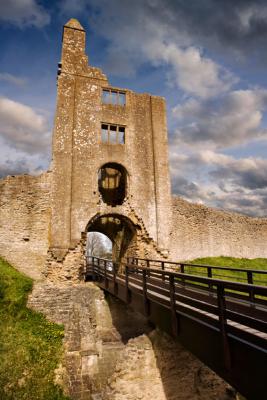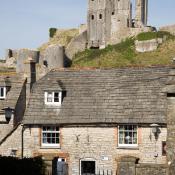The Middle Ages
Shortly after acquiring the kingdom of England, William the Conqueror ordered a census. The resulting Domesday Book documents many Saxon settlements in Dorset that correspond to modern towns. Shaftesbury, for example, grew into a bustling medieval market town and retains a medieval charm today. Shaftesbury’s steep and cobbled 'Gold Hill' is one of the most-photographed streets in England.
A number of military events shaped Dorset's history during the early middle ages. During 'the anarchy' of the twelfth century, a period characterized by unsettled government and civil war, defensive castles were built at Corfe Castle, Powerstock, Wareham, and Shaftesbury. Even monasteries, such as that at Abbotsbury, were fortified. Lyme Regis gained its royal title (Regis) in 1284, after Edward II sheltered his fleet in the harbour under the protection of the newly-built massive breakwater still known as 'The Cobb'.
Dorset's coastline was much in use during the 'Hundred Years War' with France that took place between 1337 and 1453, and it was here that the Black Death landed. Weymouth, in 1348, was one of the first towns in England to experience the epidemic. While the population of Dorset was shrinking dramatically and many towns and villages disappearing altogether, those members of the monarchy and nobility who were not either fighting or dying created deer parks for the purposes of recreational hunting. Many of them, like Gillingham and Sherborne, still remain.
Just as the county had begun to recover from the ravages of war and disease, along came The Reformation to further threaten peace and economic growth. The effects of religious persecution were quickly felt. Mary Tudor stopped an ancient grant for maintenance of the Cobb in Lyme Regis, calling it a 'heretic town', and Henry VIII's Dissolution of the Monasteries closed the abbeys at Sherborne, Shaftesbury, Milton Abbas, Abbotsbury and Cerne Abbas, redistributing the land among those who had helped him enforce the new religious order.
Sir Giles Strangeways, for example, Earl of Ilchester and one of Henry VIII's commissioners for the dissolution in Dorset in 1541, was given the 11th century Benedictine Monastery at Abbotsbury, together with its extensive lands and swannery. The estate has remained in the Strageways family ever since. Many local people paid dearly for their religious beliefs. Some of them, such as the Chideock Martyrs, executed at Dorchester on the 4th July 1594, even made it into the history books.
The Reformation was quickly followed up by the Civil War. Everyone from nobility to laborers joined the 17th century fight between Royalists and Parliamentarians, with villages often split dangerously down the middle. While Dorset had a number of Royalist strongholds, such as Sherborne Castle and Corfe Castle (both of which were devastated by fighting), many towns, such as Weymouth, were under the control of the parliamentarians.
Much plotting and intrigue went on among the two sides, often resulting in fierce and bloody battles, such as that which took place at Weymouth as a result of what is known as The Crabchurch Conspiracy, recently related in a book by local author Mark Vine.
On the night of February 9th 1645, the parliamentarian forces of Weymouth and Melcombe, under the control of Governor William Sydenham, were attacked in the dead of night by a group of Royalists from Portland, aided by spies from Weymouth and Melcombe. During the conflict William's brother, Francis, was killed. In revenge, William laid an intricate plot of ambush that led to him defeating 6000 Royalists virtually single handed, after which the locals involved in the conspiracy were executed during what are known as the Nothe Hangings.
Some country folk, fed up with all this wanton destruction, formed a group called the Dorset Clubmen. Armed with clubs, pitchforks and scythes they fought against both sides in a united, if ill-fated, effort to defend their crops and animals. The largest battle in Dorset was in fact waged between the Clubmen and Oliver Cromwell on Hambledon Hill in 1645. Of the 2-4,000 clubmen, who outnumbered Cromwell's troops by around 4 to 1, most fled, some locking themselves in the church overnight, to suffer the humility of Cromwell calling them 'poor, silly creatures'.
Shortly after the civil war subsided Dorset became entangled in yet another dangerous conspiracy, the Monmouth Rebellion, which led to yet more executions. In June 1685, the Duke of Monmouth landed forces on the beach at Lyme Regis in an attempt to overthrow the rulership of King James II. The rebels finally met the king's men in Somerset and were roundly defeated during what was to be the last battle in England to be fought with pitchforks. James II sent a cruel and corrupt Lord Chief Justice, Judge George Jeffreys, to Dorset to punish the rebels in an episode that has gone down in history as the Bloody Assizes. Nearly 200 were condemned to death, many protesting innocence, and 800 were sent to the new world.
- History












